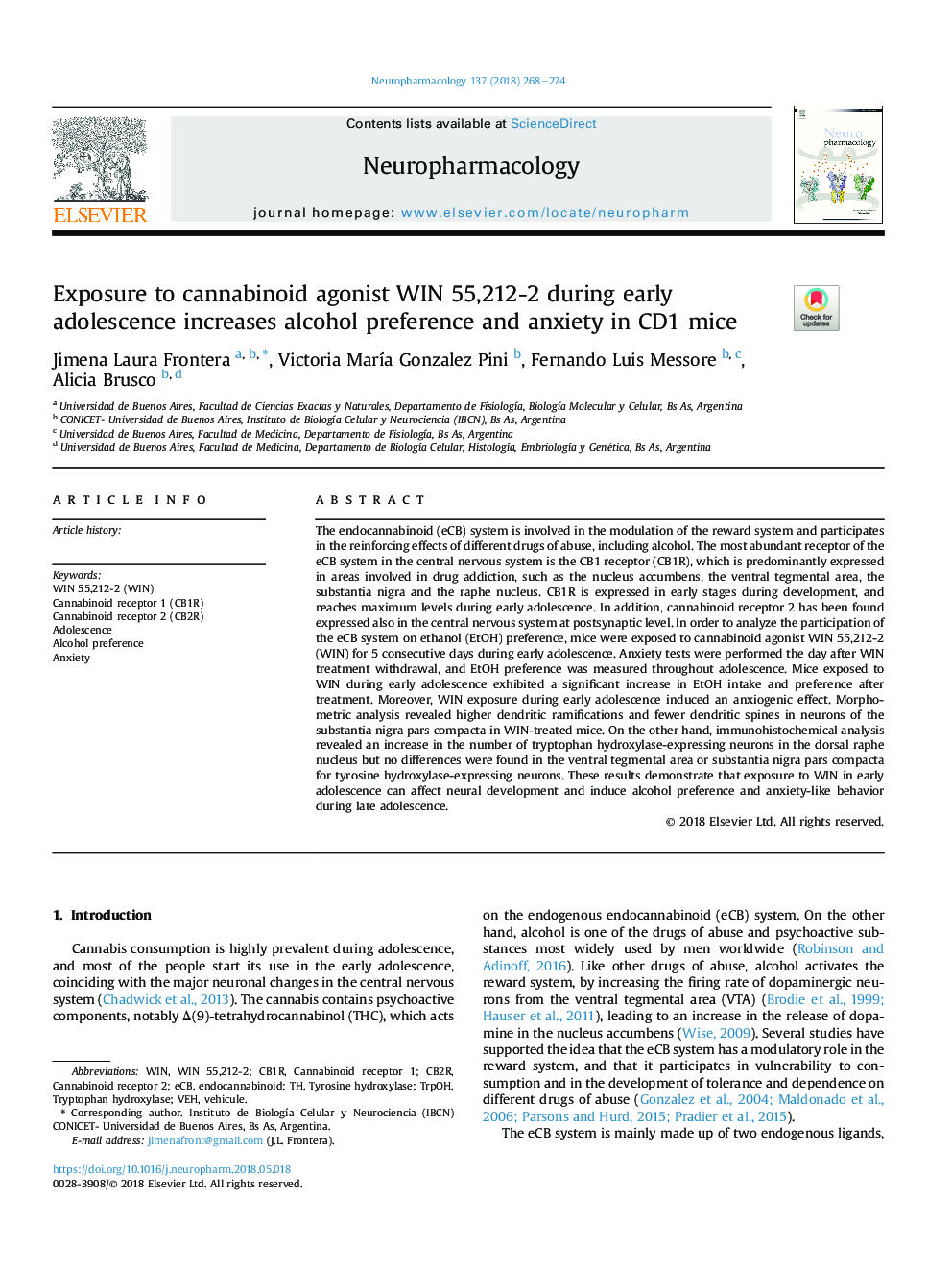| کد مقاله | کد نشریه | سال انتشار | مقاله انگلیسی | نسخه تمام متن |
|---|---|---|---|---|
| 8516499 | 1556577 | 2018 | 7 صفحه PDF | دانلود رایگان |
عنوان انگلیسی مقاله ISI
Exposure to cannabinoid agonist WIN 55,212-2 during early adolescence increases alcohol preference and anxiety in CD1 mice
دانلود مقاله + سفارش ترجمه
دانلود مقاله ISI انگلیسی
رایگان برای ایرانیان
کلمات کلیدی
CB1RCB2ReCBWIN 55,212-2 - WIN 55،212-2endocannabinoid - آندوکانابینوئیدAnxiety - اضطرابAdolescence - بلوغ، دوره جوانی، نوجوانیAlcohol preference - ترجیح الکلtyrosine hydroxylase - تیروزین هیدروکسیلازtryptophan hydroxylase - هیدروکسیلاز تریپتوفانveh - وایWIN - پیروزیCannabinoid receptor 1 - گیرنده کانابینوئید 1cannabinoid receptor 2 - گیرنده کانابینوئید 2
موضوعات مرتبط
علوم زیستی و بیوفناوری
علم عصب شناسی
علوم اعصاب رفتاری
پیش نمایش صفحه اول مقاله

چکیده انگلیسی
The endocannabinoid (eCB) system is involved in the modulation of the reward system and participates in the reinforcing effects of different drugs of abuse, including alcohol. The most abundant receptor of the eCB system in the central nervous system is the CB1 receptor (CB1R), which is predominantly expressed in areas involved in drug addiction, such as the nucleus accumbens, the ventral tegmental area, the substantia nigra and the raphe nucleus. CB1R is expressed in early stages during development, and reaches maximum levels during early adolescence. In addition, cannabinoid receptor 2 has been found expressed also in the central nervous system at postsynaptic level. In order to analyze the participation of the eCB system on ethanol (EtOH) preference, mice were exposed to cannabinoid agonist WIN 55,212-2 (WIN) for 5 consecutive days during early adolescence. Anxiety tests were performed the day after WIN treatment withdrawal, and EtOH preference was measured throughout adolescence. Mice exposed to WIN during early adolescence exhibited a significant increase in EtOH intake and preference after treatment. Moreover, WIN exposure during early adolescence induced an anxiogenic effect. Morphometric analysis revealed higher dendritic ramifications and fewer dendritic spines in neurons of the substantia nigra pars compacta in WIN-treated mice. On the other hand, immunohistochemical analysis revealed an increase in the number of tryptophan hydroxylase-expressing neurons in the dorsal raphe nucleus but no differences were found in the ventral tegmental area or substantia nigra pars compacta for tyrosine hydroxylase-expressing neurons. These results demonstrate that exposure to WIN in early adolescence can affect neural development and induce alcohol preference and anxiety-like behavior during late adolescence.
ناشر
Database: Elsevier - ScienceDirect (ساینس دایرکت)
Journal: Neuropharmacology - Volume 137, 15 July 2018, Pages 268-274
Journal: Neuropharmacology - Volume 137, 15 July 2018, Pages 268-274
نویسندگان
Jimena Laura Frontera, Victoria MarÃa Gonzalez Pini, Fernando Luis Messore, Alicia Brusco,